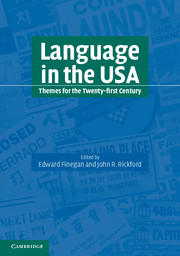Book contents
- Frontmatter
- Contents
- List of figures
- List of tables
- List of contributors
- Acknowledgments
- Foreword
- Editors' preface
- Part 1 American English
- 1 American English: its origins and history
- 2 American English and its distinctiveness
- 3 Regional dialects
- 4 Social varieties of American English
- 5 African American English
- 6 The Dictionary of American Regional English
- Part 2 Other language varieties
- Part 3 The sociolinguistic situation
- Index
2 - American English and its distinctiveness
Published online by Cambridge University Press: 05 June 2012
- Frontmatter
- Contents
- List of figures
- List of tables
- List of contributors
- Acknowledgments
- Foreword
- Editors' preface
- Part 1 American English
- 1 American English: its origins and history
- 2 American English and its distinctiveness
- 3 Regional dialects
- 4 Social varieties of American English
- 5 African American English
- 6 The Dictionary of American Regional English
- Part 2 Other language varieties
- Part 3 The sociolinguistic situation
- Index
Summary
Editors' introduction
This chapter explores a topic of enduring interest to many Americans (and their counterparts in England): the distinctiveness of American English vis-à-vis British English. After cautioning that we should be careful to consider features in comparable registers or situations (e.g., newspaper writing with newspaper writing and conversation with conversation), Edward Finegan launches into a discussion of vocabulary differences on either side of the Atlantic. Many of the examples he discusses involve automobiles, traffic, and travel (British motorway and roundabout vs. American freeway and traffic circle), but other domains – household items and package labels – are rich in contrasts too. A noteworthy source of distinctive American words (some very old) are those borrowed from the languages of Native American and Latino populations, including place names like Malibu (from Chumash) and El Paso (from Spanish) and foods like persimmon and tortilla.
Going beyond the stereotypical “tomayto/tomahto” examples, the chapter surveys a number of recurrent pronunciation differences between American and British English, some involving consonants (pronouncing /t/ in words like auto as a sound like [d] or as an aspirated [th]), some vowels (“mo-bal” vs. “mo-bile”), and some stress or accent (garáge vs. gárage). Among other things noted, regional pronunciation is less varied in the USA than in Britain; although Britain is geographically smaller, it has a longer and more complex settlement history.
Contrary to the popular perception that there are few grammatical differences between American English and British English, this chapter draws our attention to a wide range of examples.
- Type
- Chapter
- Information
- Language in the USAThemes for the Twenty-first Century, pp. 18 - 38Publisher: Cambridge University PressPrint publication year: 2004
- 6
- Cited by



